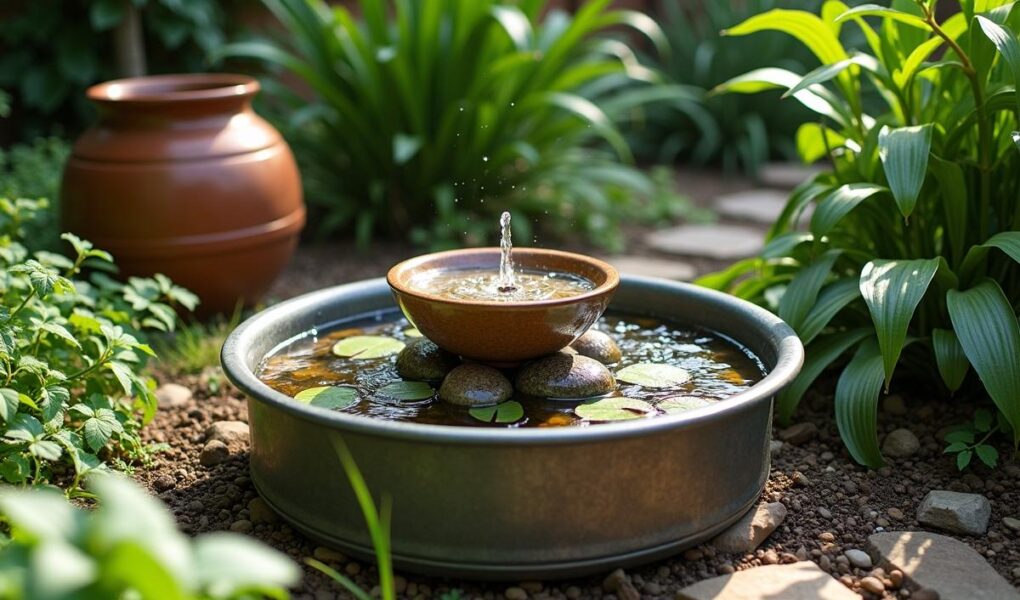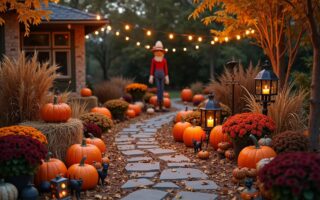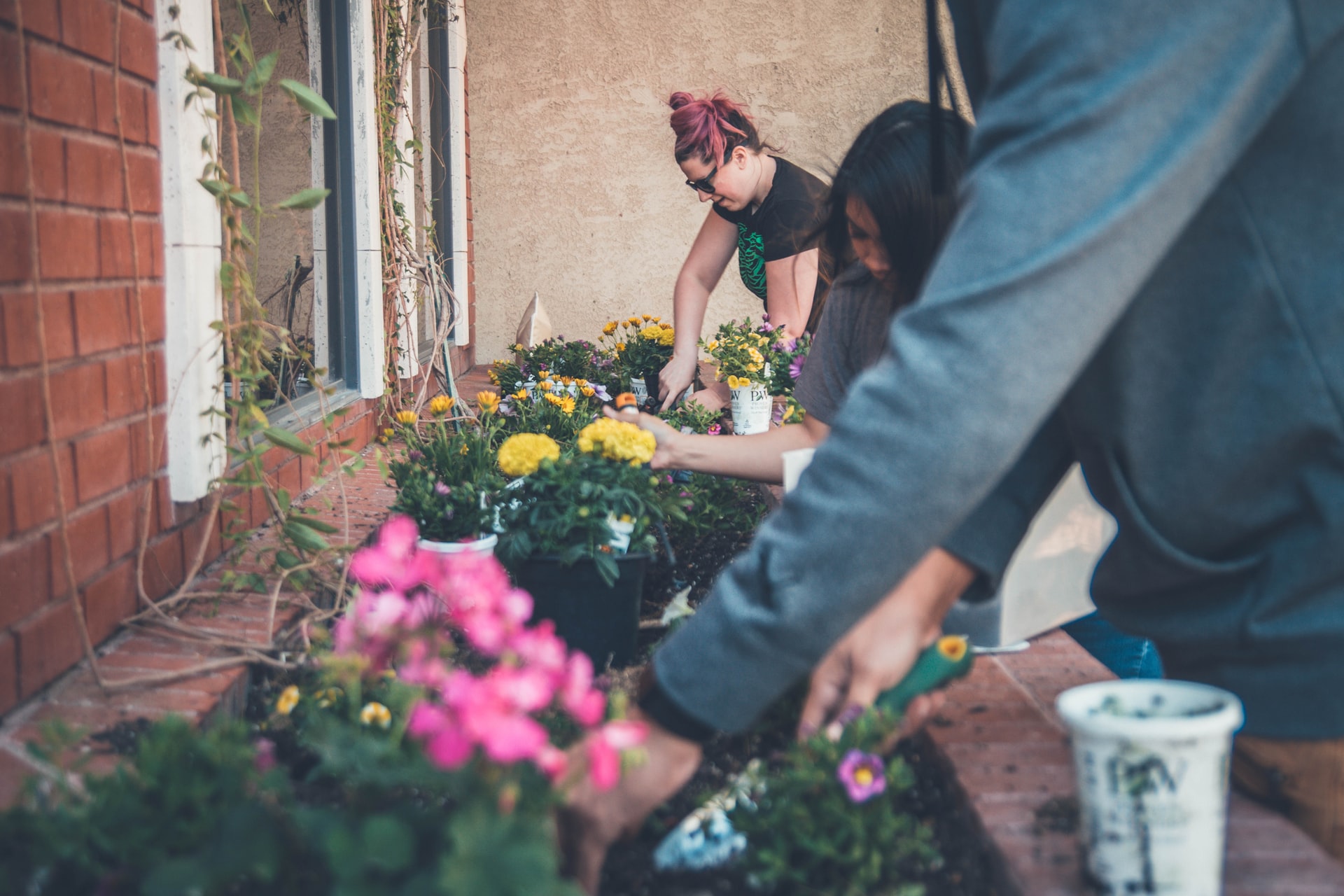Transform your outdoor space with DIY water features to add tranquility and charm. They can be as simple or as elaborate as you’d like, from small fountain bowls to carefully crafted pond-like setups that become the focal point of your yard. Think of them as an artistic extension of your home that also supports healthy plants through strategic garden watering systems.
Transform Your Space With Fountain-Like Creations
Some people imagine stone fountains or large ponds when they think of water features. However, smaller and more affordable options also exist. You can customize a container, add a pump, and enjoy the soothing sound of trickling water without digging up half your garden.
Choosing the Right Container
Metal tubs, wooden barrels, or large ceramic pots all work nicely. Make sure you have enough depth so a small pump can fit. A container around 18 to 24 inches deep works well for homemade irrigation setups. Tuck it in a corner with good visibility, and surround it with plants for a natural look.
Creating a Focal Point
A simple fountain bowl can become a statement piece. You might place decorative rocks inside or even float small lilies if sunlight permits. Combine water lilies with soaker hoses around the edges for efficient watering of nearby landscapes. This synergy helps your garden moisture control while maintaining a polished aesthetic.
Drip Irrigation DIY and Rainwater Harvesting
Large fountain features often include hidden plumbing that recirculates water. Consider using these principles for your day-to-day watering needs. By adding drip irrigation DIY methods to your garden, you simultaneously enhance plant vigor and conserve resources. Rainwater harvesting systems, which collect runoff from roofs, also work wonders for eco-friendly watering methods.
Installing Simple Drip Lines
Drip tubing with emitters can be run around your garden beds, delivering water precisely where it’s needed. This reduces waste and helps with water conservation gardening. Many gardeners pair drip lines with battery-operated water timers. Program them to run at optimal times, like mornings or late evenings, to minimize evaporation.
Rainwater Collection Tactics
Collecting rainwater is a nifty way to support a homemade garden watering system. Install rain barrels under your gutter downspouts, then connect them to your drip lines or garden hose extensions. This setup reduces dependency on city water and adds a layer of protection for your plants during dry spells. If you’re into self-watering garden ideas, you’ll discover that combining drip irrigation with harvested rainwater works seamlessly.
Delving Into Flowing Streams and Cascades
Some gardens benefit from a moving water element. Cascades or artificial streams can weave through a yard or trickle over ornamental rocks. If you plan it well, you can pair these features with terrace garden irrigation, ensuring each level of your sloped yard gets watered efficiently.
Components of a Cascading Feature
A small pump at the lowest point propels water upward through hidden tubing. Gravity carries it downstream, creating a gentle flow that keeps water well-oxygenated. With thoughtful placement, your plants near the stream can benefit from occasional oversplash, aiding water moisture control. For a curated look, try mixing in companion planting for moisture along the banks.
Balancing Beauty and Maintenance
Like outdoor sprinklers, these features can occasionally clog or lose pressure. Regular checks and cleaning keep them flowing beautifully. Take advantage of a garden hose extension for power-washing rocks or removing debris that may impede water flow. Combine the cascade with self-watering pots on either side for an eye-catching arrangement.
Automatic Garden Watering and Seasonal Strategies
Establishing simpler ways to keep your outdoor haven healthy is often the top priority. Automatic garden watering systems can save time and ensure consistent moisture. By integrating seasonal watering strategies, you can condition your garden to thrive throughout the year.
Using Battery-Operated Water Timers
If you have a standard garden hose, hooking up a battery-operated water timer takes minimal effort. Set daily schedules so your plants receive consistent irrigation. This approach often outperforms manual watering cans, which, while classic, can lead to inconsistent routines if shortages of time occur.
Addressing Urban Garden Irrigation
In more compact settings, such as city backyards or rooftop terraces, water features should complement container plants. Drip irrigation DIY kits scaled down to fit planters are perfect for tight urban spots. Self-watering pots with built-in reservoirs also reduce the need for frequent monitoring, especially if you’re out of town.
Water Conservation Gardening and Creative Sculptures
Water conservation doesn’t mean dull landscaping. Try integrating sculptural pieces that combine function and flair. For instance, a carved stone pillar that gently overflows can function as a small fountain while blending well with flowering plants.
Incorporating Low-Cost Garden Water Solutions
Repurposing materials helps you get started without spending a fortune. Old troughs, wine barrels, or even deep basins can become tranquil water spots. With a few simple additions, you’ll have a homemade sprinkler system for your plants, limiting waste and promoting sustainable garden watering. If you’re inclined to experiment further, a DIY drip system for plants is easy to set up and can pair well with modest sculptures.
Boosting Efficiency With Companion Planting
Certain plants placed alongside each other help maintain soil moisture. Companion planting for moisture ensures that densely planted beds share water resources better, leading to robust growth. This strategy reduces reliance on frequent watering, cutting down on daily chores.
Enhancing Terraces and Balconies With Eco-Friendly Watering Methods
Urban dwellers with smaller spaces can still benefit from water features. Instead of a large pond, consider a compact creation. By pairing a small fountain with a self-watering pot arrangement, you bring a slice of nature to high-rise living.
Techniques for Terrace Garden Irrigation
Terrace garden irrigation can include drip lines, soaker hoses, or clever solutions like wicking beds. Balcony gardens sometimes use shallow containers, so introducing a DIY water saving garden tip, like a small reservoir beneath each container, can be a real game-changer. Attaching a simple irrigation system homemade from spare tubing and recycled barrels can keep plant roots consistently moist.
Maintaining Freshness in Tight Quarters
With limited space, you want every inch to feel inviting. A petite water feature, even just a small ceramic bowl with a pump, contributes gentle gurgling sounds that help you unwind. Surround it with plants chosen for their minimal water needs, ensuring that water conservation gardening remains a priority. If your balcony gets full sun, remember to adjust your watering schedule to counteract faster evaporation.
Garden Hose Extensions and Self-Watering Pots in Larger Yards
Those with bigger backyards can explore various expansions. Hose extensions reach far corners, meaning no more lugging watering cans everywhere. Self-watering pots, placed strategically, allow you to display bright blooms without frequent check-ins.
Practical Steps for Larger Landscapes
Start by mapping out your garden irrigation setup. Identify high-need areas, such as a veggie patch or flower bed. Then, select an efficient irrigation system homemade or store-bought, like drip irrigation or a network of soaker hoses. If you need to water fruit trees or sprawling shrubs, a homemade garden watering device, such as a slow-release jug buried near the root zone, can do wonders.
Merging Function and Style
Large yards can incorporate decorative pond-like features, complete with aquatic plants. Some gardeners add fish to these ponds for mosquito control. In other areas, installing an outdoor sprinklers system keeps lawns lush. For ultimate synergy, combine efficient garden watering with a calm water feature that acts as the centerpiece of your backyard paradise.
Final Thoughts on Diy Garden Water Features
Water features can elevate your yard while supporting efficient and thoughtful irrigation. Integrating everything from a drip irrigation system DIY to rainwater collection for gardens ensures that you save resources and reduce your monthly bills. Look for innovative ways to unite form and function in your landscaping, whether you’re in the suburbs or nurturing an urban garden irrigation plan.
Seasonal watering strategies should guide your approach, adjusting as temperatures fluctuate. On scorching summer days, you might need more watering sessions, while cooler months offer a chance to reduce frequency. By blending these tactics with a peaceful water feature, you’ll create a space that both you and your plants can truly enjoy.




